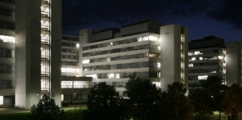CeBiTec – Colloquium
Monday, 20 November, 2017, 17 c.t.
G2-104, CeBiTec Building
Dr. Romy Schmidt
Institute of Biology I (Botany/Molecular Genetics) RWTH Aachen University
A burst of reactive oxygen species: Unraveling the role of ROS signaling and homeostasis during flooding stress in plants
Flooding of plants causes an impairment of aerobic metabolism as oxygen diffusion is limited, resulting in the activation of hypoxic responses. The activation of energy-saving and fermentative pathways is directed by transcription factors of the group VII ETHYLENE-RESPONSE FACTOR (ERFVII) family. Despite the eminent role of ERFVIIs in hypoxia signaling, the upstream signals and molecular components which activate the diverse transcriptional pathways during low-oxygen stress are unknown.
Through diverse approaches we demonstrate that a hypoxia-induced reactive oxygen species (ROS) burst occurs, and that it contributes to low-oxygen adaptation. Interestingly, this ROS burst is generated by both mitochondria and plasma membrane-located NADPH-oxidases. In addition, specific NADPH oxidases affect plant survival upon low oxygen stress, and to some extend the expression of ERFVII-regulated genes. Next to the ability to generate ROS, also maintenance of ROS homeostasis has a profound effect on hypoxia tolerance and the initial expression of hypoxia-responsive genes.
Taken together, ROS homeostasis and signaling are important for adaptation towards hypoxic conditions. Moreover, we suggest that different cellular compartments contribute to the hypoxia-induced ROS burst and thereby generate an integrative ROS signal that defines hypoxia stress specificity.
Through diverse approaches we demonstrate that a hypoxia-induced reactive oxygen species (ROS) burst occurs, and that it contributes to low-oxygen adaptation. Interestingly, this ROS burst is generated by both mitochondria and plasma membrane-located NADPH-oxidases. In addition, specific NADPH oxidases affect plant survival upon low oxygen stress, and to some extend the expression of ERFVII-regulated genes. Next to the ability to generate ROS, also maintenance of ROS homeostasis has a profound effect on hypoxia tolerance and the initial expression of hypoxia-responsive genes.
Taken together, ROS homeostasis and signaling are important for adaptation towards hypoxic conditions. Moreover, we suggest that different cellular compartments contribute to the hypoxia-induced ROS burst and thereby generate an integrative ROS signal that defines hypoxia stress specificity.
Host: Prof. Dr. Karl-Josef Dietz



